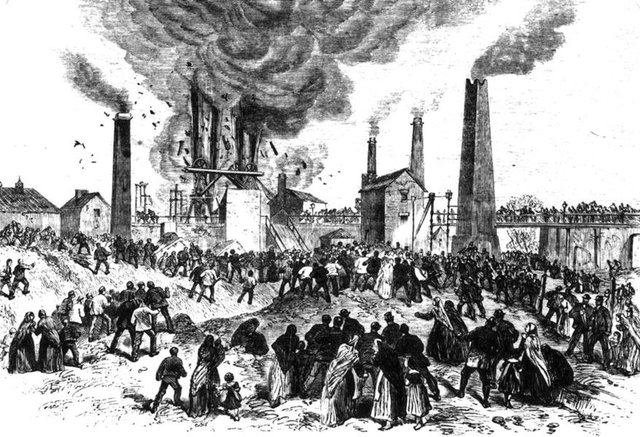|
Oaks Explosion
The Oaks explosion, which happened at a coal mine in West Riding of Yorkshire on 12 December 1866, remains the worst mining accident, mining disaster in England. A series of explosions caused by firedamp ripped through the underground workings at the Oaks Colliery at Hoyle Mill near Stairfoot in Barnsley killing 361 miners and rescuers. It was the worst mining disaster in the United Kingdom until the 1913 Senghenydd colliery disaster, Senghenydd explosion in Wales. Oaks Colliery The first shaft at the Oaks Colliery was sunk in the early 1830s. In 1845 two separate explosions occurred at the Coal mining, colliery. On both occasions few men were below ground and no more than three or four workers died. Two years later a more serious incident occurred after firedamp, which had accumulated in old workings, was ignited and exploded. Of the men underground, 73 were killed and 26 were rescued. Changes were then made to the colliery's Underground mine ventilation, ventilation. The d ... [...More Info...] [...Related Items...] OR: [Wikipedia] [Google] [Baidu] |
Illustrated London News
''The Illustrated London News'' appeared first on Saturday 14 May 1842, as the world's first illustrated weekly news magazine. Founded by Herbert Ingram, it appeared weekly until 1971, then less frequently thereafter, and ceased publication in 2003. The company continues today as Illustrated London News Ltd, a publishing, content, and digital agency in London, which holds the publication and business archives of the magazine. History 1842–1860: Herbert Ingram ''The Illustrated London News'' founder Herbert Ingram was born in Boston, Lincolnshire, in 1811, and opened a printing, newsagent, and bookselling business in Nottingham around 1834 in partnership with his brother-in-law, Nathaniel Cooke.Isabel Bailey"Ingram, Herbert (1811–1860)" ''Oxford Dictionary of National Biography'', Oxford University Press, 2004 accessed 17 September 2014] As a newsagent, Ingram was struck by the reliable increase in newspaper sales when they featured pictures and shocking stories. Ingram beg ... [...More Info...] [...Related Items...] OR: [Wikipedia] [Google] [Baidu] |
Barrow Colliery
Barrow Colliery was a coal mine in Worsborough, South Yorkshire, England. It was first dug in 1873, with the first coal being brought to the surface in January 1876. It was the scene of a major incident in 1907 when seven miners died. After 109 years of coaling operations, the mine was closed in May 1985. History The mine was located in Blacker on the south side of Worsborough, South Yorkshire, but was called Barrow Colliery after the owners who sunk the mine, The Barrow Haematite Steel Company, which had other coal mines in operation though mainly in the Cumbrian and Lancashire coalfields. The company had purchased land in 1872 next to a former mine, Worsborough Park Colliery, that had been abandoned. Digging started in 1873, although coal was not won until 1876 after 18 months' worth of Digging. The company wanted access to good coal and coking coal reserves, as it consumed over of it per year in its steelmaking enterprise. The mine operated for 109 years with a pause in prod ... [...More Info...] [...Related Items...] OR: [Wikipedia] [Google] [Baidu] |
Colliery Viewer
A colliery viewer or coal viewer was the manager of a coal mine or colliery. The term was mostly used in the late eighteenth to nineteenth centuries, in the UK. In modern use, the viewer would be the senior and responsible mining engineer at a site. Origins The role began as a person to represent the owner of the land, often an aristocrat, who had leased the rights to mine there to another who would 'work' the mine. One of the first formally recorded arrangements for such was at the Ironbridge Gorge in 1608, where Jesse Whittingham leased four adits from James Clifford, at a rent of £200 a year for five years. Clifford had acquired the lands of Wenlock Priory at Broseley in 1560, after the priory's dissolution in 1540. Several such monastic lands moved from traditional tenant farming to entrepreneurial mineral exploitation at this time, spurring the early industrial revolution, particularly around the Gorge. Land at this time was rarely sold, the aristocratic estates were in ... [...More Info...] [...Related Items...] OR: [Wikipedia] [Google] [Baidu] |
Headframe
A headframe (also known as a gallows frame, winding tower, hoist frame,Ernst, Dr.-Ing. Richard (1989). ''Wörterbuch der Industriellen Technik'' (5th ed.). Wiesbaden: Oscar Brandstetter, 1989. pit frame, shafthead frame, headgear, headstock or poppethead) is the structural frame above an underground mine shaft so as to enable the hoisting of machinery, personnel, or materials. Design Modern headframes are built out of steel, concrete or a combination of both. Timber headframes are no longer used in industrialized countries, but are still used in developing nations. Conventionally steel headframes are used when a drum hoist is employed, and concrete headframes are built for friction hoists; however a steel headframe can be used with a friction hoist for shafts with a smaller capacity and depth. Steel headframes A steel headframe is less expensive than a concrete headframe; the tallest steel headframe measures 87 m. Steel headframes are more adaptable to modifications (mak ... [...More Info...] [...Related Items...] OR: [Wikipedia] [Google] [Baidu] |
Mine Cage
Shaft mining or shaft sinking is the action of excavating a mine shaft from the top down, where there is initially no access to the bottom. Shallow shafts, typically sunk for civil engineering projects, differ greatly in execution method from deep shafts, typically sunk for mining projects. Shaft sinking is one of the most difficult of all mine development methods: restricted space, gravity, groundwater and specialized procedures make the task quite formidable. Shafts may be sunk by conventional drill and blast or mechanised means. Historically, mine shaft sinking has been among the most dangerous of all the mining occupations and the preserve of mining contractors called sinkers. Today shaft sinking contractors are concentrated in Canada, Germany, China and South Africa. The modern shaft sinking industry is gradually shifting further towards greater mechanisation. Recent innovations in the form of full-face shaft boring (akin to a vertical tunnel boring machine) have shown ... [...More Info...] [...Related Items...] OR: [Wikipedia] [Google] [Baidu] |
Cage Thrown Up Into The Head-Gear At The Pit's Mouth By The Explosion At The Oaks Colliery, Barnsley ILN-1866-1229-0001
A cage is an enclosure often made of mesh, bars, or wires, used to confine, contain or protect something or someone. A cage can serve many purposes, including keeping an animal or person in captivity, capturing an animal or person, and displaying an animal at a zoo. Construction Since a cage is usually intended to hold living beings, at least some part of its structure must be such as to allow for the entry of light and air. Thus some cages may be made with bars spaced too closely together for the intended captive to slip between them, or with windows covered by a mesh of some sort. Animal cages Cages are often used to confine animals, and some are specially designed to fit a certain species of animal. One or more birds, rodents, reptiles, and even larger animals of certain breeds are sometimes confined in a cage as pets. Animal cages have been a part of human culture since ancient times. For example, an Ancient Greek vase dated to 490 B.C. depicts a boy holding a possib ... [...More Info...] [...Related Items...] OR: [Wikipedia] [Google] [Baidu] |
Hurrying
A hurrier, also sometimes called a coal drawer or coal thruster, was a child or woman employed by a collier to transport the coal that they had mined. Women would normally get the children to help them because of the difficulty of carrying the coal. Common particularly in the early 19th century, the hurrier pulled a corf (basket or small wagon) full of coal along roadways as small as in height. They would often work 12-hour shifts, making several runs down to the coal face and back to the surface again.Channel 4. The Worst Jobs in History - Hurrier. Accessed from the Wayback Machine on 13 November 2009.HalifaxToday.co.uk. The Nature Of Work". Accessed 17 February 2007. Some children came from the workhouses and were apprenticed to the colliers. Adults could not easily do the job because of the size of the roadways, which were limited on the grounds of cost and structural integrity. Hurriers were equipped with a "gurl" belt – a leather belt with a swivel chain linked to t ... [...More Info...] [...Related Items...] OR: [Wikipedia] [Google] [Baidu] |
Hewer
A hewer (german: Hauer or ''Häuer'') is a miner who loosens rock and minerals in a mine. In medieval mining in Europe a ''Hauer'' was the name given to a miner who had passed his test (''Hauerprüfung'') as a hewer. Training In Europe in former times, before he could become a hewer, the miner had to learn to be a "sorter boy" (''Scheidejunge''), identifying ores and separating the ore from the gangue. After that he would continue his training in the pit itself. Here, he had to learn further skills, initially as a putter (''Hundtstößer'' literally "truck pusher"), transporting material around the mine in wagons. Only afterwards could he learn the skills, as an apprentice hewer (''Lehrhäuer''), that he would later need as a hewer. This form of training, the acquisition of knowledge by experience, was practised in mining until the First World War. From the 1920s, the training of hewers was legally regulated as a result of union demands. Because, in the meantime, many skills re ... [...More Info...] [...Related Items...] OR: [Wikipedia] [Google] [Baidu] |
Afterdamp
Afterdamp is the toxic mixture of gases left in a mine following an explosion caused by methane-rich firedamp, which itself can initiate a much larger explosion of coal dust. The term is etymologically and practically related to other terms for underground mine gases—such as firedamp, white damp, and black damp, with afterdamp being composed, rather, primarily by carbon dioxide, carbon monoxide and nitrogen, with highly toxic stinkdamp-constituent hydrogen sulfide possibly also present. However, the high content of carbon monoxide is the component that kills, preferentially combining with haemoglobin in the blood and thus depriving victims of oxygen. Globally, afterdamp has caused many of the casualties in disasters of pit coalfields, including British, such as the Senghenydd colliery disaster. Such disasters continue to afflict working mines, for instance in mainland China. Etymology The meaning of "damp" in this term, while most commonly understood to imply humidity, presents e ... [...More Info...] [...Related Items...] OR: [Wikipedia] [Google] [Baidu] |
Drift Mining
Drift mining is either the mining of an ore deposit by underground methods, or the working of coal seams accessed by adits driven into the surface outcrop of the coal bed. A drift mine is an underground mine in which the entry or access is above water level and generally on the slope of a hill, driven horizontally into the ore seam. Random House dictionary says the origin of the term "drift mine" is an Americanism, circa 1885–1890. Drift is a more general mining term, meaning a near-horizontal passageway in a mine, following the bed (of coal, for instance) or vein of ore. A drift may or may not intersect the ground surface. A drift follows the vein, as distinguished from a crosscut that intersects it, or a level or gallery, which may do either. All horizontal or subhorizontal development openings made in a mine have the generic name of drift. These are simply tunnels made in the rock, with a size and shape depending on their use—for example, haulage, ventilation, or exp ... [...More Info...] [...Related Items...] OR: [Wikipedia] [Google] [Baidu] |
Parkin Jeffcock
Parkin Jeffcock (27 October 1829 – 13 December 1866) was an English mining engineer who died trying to effect the rescue of miners during the Oaks mining disaster which eventually killed more than 350 people. Biography Parkin was born on 27 October 1829 at Cowley Manor in Ecclesfield in the West Riding of Yorkshire, now a part of Sheffield. He was the son of John Jeffcock J.P. (1803–78) and his wife Catherine (1804–72, ''née'' Parkin) Lady of the Manor of Darley. He intended to go to Oriel College, Oxford and then enter holy orders but instead entered a college for civil engineers at Putney, which under the presidency of the Duke of Cambridge and the principalship of the Rev. B.M. Cowrie, was doing good work for that profession. In 1850, after training at the College for Civil Engineers, he was articled to George Hunter, a colliery viewer and engineer from Durham. He made rapid progress in his profession, and in 1857 became a partner of J.T. Woodhouse, a mining enginee ... [...More Info...] [...Related Items...] OR: [Wikipedia] [Google] [Baidu] |
Methane
Methane ( , ) is a chemical compound with the chemical formula (one carbon atom bonded to four hydrogen atoms). It is a group-14 hydride, the simplest alkane, and the main constituent of natural gas. The relative abundance of methane on Earth makes it an economically attractive fuel, although capturing and storing it poses technical challenges due to its gaseous state under normal conditions for temperature and pressure. Naturally occurring methane is found both below ground and under the seafloor and is formed by both geological and biological processes. The largest reservoir of methane is under the seafloor in the form of methane clathrates. When methane reaches the surface and the atmosphere, it is known as atmospheric methane. The Earth's atmospheric methane concentration has increased by about 150% since 1750, and it accounts for 20% of the total radiative forcing from all of the long-lived and globally mixed greenhouse gases. It has also been detected on other plane ... [...More Info...] [...Related Items...] OR: [Wikipedia] [Google] [Baidu] |










